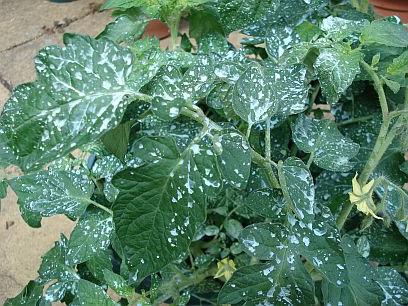Copper chloride - description, application
Copper chloride (or "Hom", copper oxychloride,blitox, cuprikol, zltozan, cupriotox) - refers to fungicides of medium toxicity. It allows you to effectively combat various plant diseases: with brown spots, macrosporium, late blight, scab, curly, powdery mildew, rust.

Copper chloride (average price is 16-18rub. for packing in 40 g.) does not have side effects on the treated plants. When contact requires protective measures (gloves, mask, glasses). The drug, accidentally trapped on the skin or in the eyes, should be immediately washed off with plenty of running clean water. For bees, fungicide is low toxicity, however, it is better to isolate the hives before treatment (with a minimum of 6 hours after treatment).
The drug copper oxychloride - an analog of Bordeauxfluid (substitute). A small minus, associated with a weaker retention on the plant, is neutralized by a significant advantage, which lies in the simplicity of preparation of the working solution (the preparation simply mixes with water and dissolves rapidly in it).
Plants should be sprayed only during the growing season.
Methods of application for protection against diseases

2. Against the curly leaves of apricots, cherries, peaches, plums and sweet cherries, four sprayings are required against coccomicosis and клястероспориоза: the first - with swollen but not bloomed buds, the second - immediately after flowering, two more - with a two-week interval. The rate of consumption is 35 g. on a bucket of water (on average).
3. To protect potatoes from macrosporia and from late blight, five treatments are required: in the case of budding, the first treatment (for insurance), if there are signs of one of these diseases, the next treatment, three subsequent ones, if necessary, with a two-week interval. Consumption - 40 gr. on a bucket of water. On the treated sites, the larvae of the Colorado beetles also die, and the mature insects of the treated plantations are cautious.
4. To protect the crops (landings) of onions or cucumbers from peronosporosis, the treatment is carried out only when the signs of one of the named diseases are revealed. Repeated treatment - after two weeks. Consumption - 40 gr. on a bucket of water.
5. When peronosporoze hops treatment is carried out to identify the disease, then - every 16 days, if the weather is dry, and every 10 days, if it rains.
The last treatment can be carried out three weeks before the harvest, regardless of the type of crop.

To increase the retention (stickiness) of the solution, it is recommended to add a small amount of 1% skimmed milk.
Copper chloride for most of the crops is non-phytidic, however, tender, especially sensitive plants can subsequently be burned.
The drug is well combined with manypesticides and with reasonable use shows very high efficiency. The shelf life of copper chloride, packed in paper bags, is almost unlimited.




